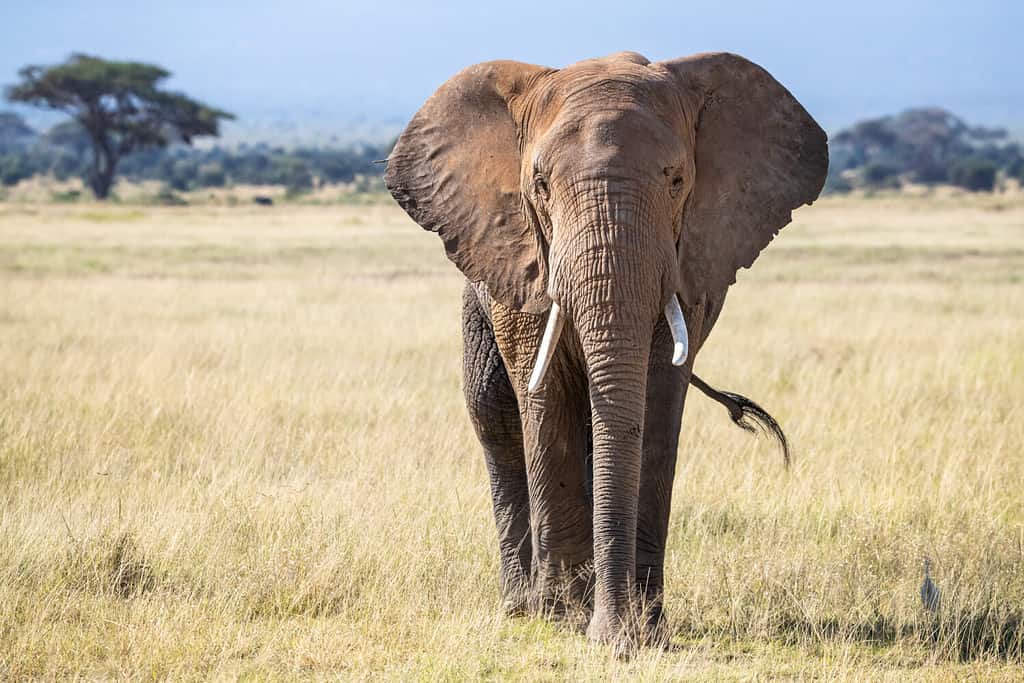The first thing people see when they look at an elephant is its immense size. But who could blame them? They are the largest land mammals alive today. However, what is less noticeable is the differences between male and female elephants. For example, telling the genders apart is challenging as their genitals are located between the elephant’s huge hind legs, and nobody wants to get close enough to these giants to peak. So, if you can see their genitals, how do you tell them apart? When it comes to male vs. female elephants, there are seven key differences.
Comparing a Male and Female Elephant
| Differences | Male Elephant | Female Elephant |
|---|---|---|
| Size | 10.5 feet tall by the shoulder and 11,000 to 15,0000 pounds. | 8 feet tall by the shoulder and 6,000 to 8,000 pounds |
| Physical Traits | Broader between the eyes and forehead. | Steep angle on the forehead, giving them a blockier forehead. |
| Reproduction | Sexually mature between 12-15 years, though they usually do not breed until their mid to late 20s. | Sexually mature at 14 years of age. |
| Social Structure | Mostly solitary | Social |
| Behavior | Dominant and aggressive | Non-competitive |
| Health | Usually, males don’t live as long as females. | Females typically live longer. |
| Musth Period | The musth period causes loud vocalizations, unpredictable behavior, pursuit of dominance, and elevated levels of competitiveness. | Musth secretion serves to consolidate the herd. |
Key Differences Between Male and Female Elephants

One of the differences between male vs. female elephants is their appearance. Males are larger than females.
©Jane Rix/Shutterstock.com
There are seven key differences between male vs. female elephants: size, physical appearance, reproduction, social structure, behavior, health, and musth period. They are described in detail below.
1. Male Vs. Female Elephant: Size

Their size varies depending on the species, but females are generally eight feet tall at the shoulder, and males 10.5 feet tall. However, the difference is more apparent in their weight.
©Peter Betts/Shutterstock.com
The best and most obvious way to tell the difference between male and female elephants is their size. Males are significantly larger than the females. Their size varies depending on the species, but females are generally eight feet tall at the shoulder, and males 10.5 feet tall. However, the difference is more apparent in their weight. A male’s weight can almost double that of a female. As a result, males often have a curvier and broader frame.
An elephant’s weight varies by species. For example, female African elephants weigh approximately 8,000 pounds, while males weigh around 15,000 pounds. However, female Asian elephants weigh about 6,000 pounds, while males usually weigh 11,000 pounds. But, while the size difference is obvious, it is not a sure way to tell them apart. For example, members of the herd could still be in their juvenile phase and not fully grown. Furthermore, males are mostly solitary, so there may not even be any adult males in the herd to compare size.
2. Male vs. Female Elephant: Physical Traits

Males’ heads are broader between the forehead and eyes. While females have a steeper angle on their foreheads, making their foreheads look blockier.
©iStock.com/geoffsp
You don’t just have to rely on size to tell these two apart. Their physical traits can also give them away. While both genders of African elephants have tusks, the males have longer tusks. However, it is more tricky with Asian elephants because they can have visible tusks called tushes. But, they are sometimes absent in females and males, depending on the subspecies and region. So, it’s not a good indicator for Asian Elephants.
Another way to tell them apart is to look at the shape of their heads. Males’ heads are broader between the forehead and eyes. While females have a steeper angle on their foreheads, making their foreheads look blockier. But again, this is only true for fully grown elephants, as juveniles have less pronounced differences, making it harder to tell them apart.
Females also have two mammary glands situated between their forelegs. It’s easy to tell when a female is pregnant because these two mammary glands become more prominent and remain so until she’s done breastfeeding.
3. Male vs. Female Elephant: Reproduction

Males become extremely aggressive around competition. Unfortunately, the younger males usually don’t stand a chance against older, stronger males for the right to mate.
©Beate Wolter/Shutterstock.com
The main difference between male vs. female elephants when it comes to reproduction is when they sexually mature. While males reach sexual maturity between 12 and 15 years old, they usually only start to breed in their mid to late 10s. However, females are sexually mature and begin to breed when they are 14 years old.
During courtship, females usually run away from the males, and this game can continue for ages before they start to mate. Males will put on a display by flapping their ears, which also helps them spread their scent further to attract a mate. However, females usually select older males between the ages of 40 and 50. While females don’t display any sort of competitiveness, males become extremely aggressive around competition. Unfortunately, the younger males usually don’t stand a chance against older, stronger males for the right to mate.
4. Male vs. Female Elephant: Social Structure

Female elephants are social creatures and usually live together in the same herd throughout their life. The oldest female (matriarch) controls the herd and includes closely related females and their calves.
©HordynskiPhotography/Shutterstock.com
Elephants belong to matriarchal communities, meaning their leader is a female, and the herd consists mostly of females. Female elephants are social creatures and usually live together in the same herd throughout their life. The oldest female (matriarch) controls the herd and includes closely related females and their calves. Everyone in the herd pitches in and helps take care of the calves. However, male elephants are primarily solitary. When they are nearing sexual maturity, they will leave the herd, and while they may form bachelor groups or socialize with other males, they spend around 95% of their lives alone.
5. Male vs. Female Elephant: Behavior

Males begin to establish a hierarchical status in early adulthood among males in the same region, evaluating each other’s skills and strengths through play fighting and sparring.
©Aelice/Shutterstock.com
Females are more peaceful than males and do not compete for mates or status. However, males engage in dominant behavior as soon as they sexually mature. Dominance is measured by the male’s size and strength. As a result, they begin to establish a hierarchical status in early adulthood among males in the same region, evaluating each other’s skills and strengths through play fighting and sparring. After the age of 25, male elephants spend the majority of their time competing for mates and eating.
6. Male vs. Female Elephant: Health

Male elephants are more aggressive and get into fights. An infected injury could lead to an early death.
©iStock.com/AndreAnita
It is a proven fact that in most mammals, the female lives longer than males. In fact, on average, they have an 18.6% longer lifespan. In elephants, researchers believe that because of the male’s immense size and large tusks take a toll on their health as they get older. Another theory is that because females have two X chromosomes, while males only have one, it affects their health and lifespan. They base this theory on birds because male birds have two X chromosomes, while females only have one, and males tend to live longer. Furthermore, male elephants are more aggressive and get into fights. An infected injury could lead to an early death.
7. Male vs. Female Elephant: Musth Period

During this period, males are loud, unpredictable, extremely competitive, and eager to pursue dominance.
©costas anton dumitrescu/Shutterstock.com
African elephants have musth glands on either side of their head. The musth period occurs once a year when these glands secrete an oily, dark, and musky substance. Researchers believe that when females experience the musth period, it consolidates the herd. However, for males, it is completely different. This is the time when they focus on raising their status in order to find a mate. During this period, males are loud, unpredictable, extremely competitive, and eager to pursue dominance.
The photo featured at the top of this post is © adogslifephoto/ via Getty Images
Thank you for reading! Have some feedback for us? Contact the AZ Animals editorial team.






